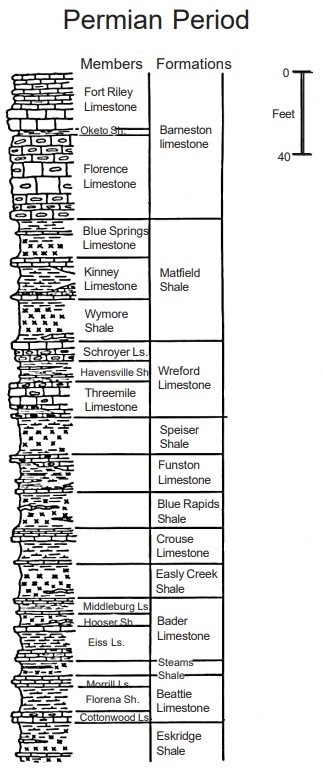
Kansas Geological Survey The Permian Period of the Paleozoic Era was approximately 250-290 million years ago. The Kansas of today was a bed under the vast, shallow Permian Sea. During this period, the earth's oceans rose and fell creating different types of aquatic environments. The warm seas supported enormous numbers of invertebrates, fish, and amphibians such as oysters, clams, snails, corals, sponges, and sea urchins. These creatures, and plants like plankton and algae, take calcium carbonate (CaCO3) out of the water and secrete it to form shells or skeletons. These organisms sank to the ocean floor as they die. Over time, the organic parts decay and the calcium carbonate accumulates to form limestone. Fossil remains of these aquatic animals can often be found in limestone. Limestone can also be formed chemically when calcium carbonate dissolved in water falls out of solution, and settles to the bottom. Geologists estimate 200 years of deposition for every inch of limestone created. Limestone layers vary in width, color, and durability due to the many variables in its creation. These sedimentary layers were named after nearby towns, creeks, or landmarks where geologists first described each of them. Sea life, minerals, water depth, and climatic conditions all contributed to the variations found in limestone. Mineral deposits often form in the cracks and pores of limestone. Calcite deposits can form of geodes and crystals in some layers. Perhaps the most well-known deposits are those from which the hills receive their name. Chert or "flint" is common in many Kansas limestones as nodules or continuous beds. It fractures with sharp, shell-like pieces. Chert is a sedimentary rock composed of microscopic crystals of quartz (silica, SiO2). Geologists are unsure what the source of silica would have been. Between the layers of limestone are softer silt and clay layers called mudstones or shale. These originated from deposits of suspended clays. Settling to the bottom and compacting, they created brittle layers of shale. Conditions in the oceans would favor shale deposits over limestone, perhaps from deeper and more turbid waters. Many events occurred at the close of the Permian Period. Land experienced many periods of rising and falling sea levels, land movement, and crust shifts. The Rocky Mountains rose creating new weather patterns. Erosion began slowly peeling away the sediments that was formed so many millions of years ago. Finally, within the last 20,000 years or so, the Flint Hills would have begun to look much like the landscape we have today. The limestone layers with their deposits of chert are more resistant to weathering and remain prominent hilltops. The softer shale under them erode into the valley and watersheds. This creates the bench and slope, or terraced topography we see on the preserve. As the limestone and the shale erode away, the more resistant flint is left behind creating very rocky soils. For further reading: Kansas Geology: An Introduction to Landscapes, Rocks, Minerals, and Fossils Edited by Rex Buchanan, University Press of Kansas, 1984. ù Ancient Life Found in Kansas Rocks: An Introduction to Common Kansas Fossils by Roger B. Williams, Kansas Geological Survey, Educational Series I, 1975. ù Konza Prairie: A Tallgrass Natural History by O.J. Reichman, University Press of Kansas, 1991. |
Last updated: March 2, 2022
